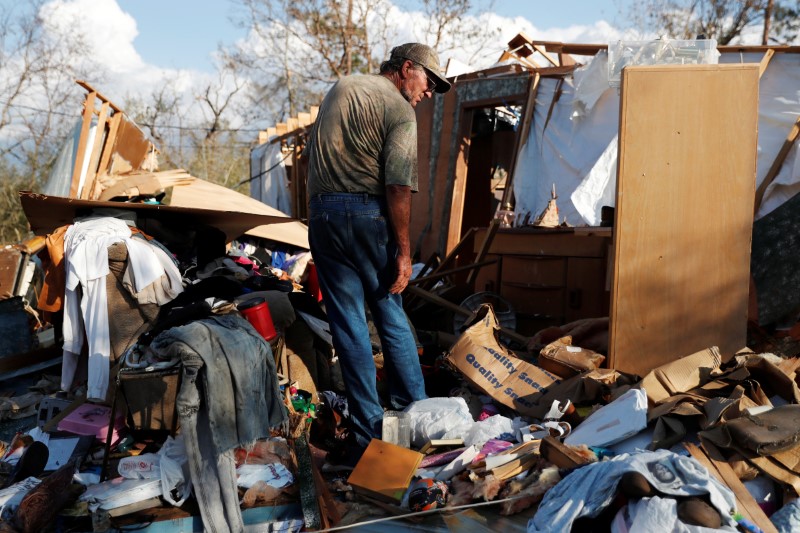
By Amanda Becker
ELIZABETH CITY, N.C. (Reuters) – Hurricane Dorian made landfall on the Outer Banks of North Carolina on Friday, hitting the beach resort area with powerful winds and battering waves days after reducing parts of the Bahamas to rubble.
The storm, packing 90-mile-per-hour winds (150 km-per-hour) made landfall at Cape Hatteras at about 9 a.m. EDT (1300 GMT), according to the National Hurricane Center.
It lashed the Outer Banks with hurricane-force winds as far as 45 miles (72 km) from the center of the hurricane and sent tropical storm winds farther than 200 miles (320 km) from its center, the NHC said.
It has already dumped up to 10 inches (25 cm) of rain along the coast between Charleston, South Carolina, to Wilmington, North Carolina, about 170 miles (275 km) away, forecasters said.
“The rain is moving up north,” said National Weather Service forecaster Alex Lamers early on Friday. “Even the Raleigh-Durham area inland will get 3 inches today.”
Dorian is expected to push out to sea later on Friday and bring tropical storm winds to Nantucket Island and Martha’s Vineyard, Massachusetts, early on Saturday.
But it will likely spare much of the rest of the East Coast the worst of its rain and wind, before likely making landfall in Canada’s Nova Scotia that night, the NHC said.
“It’s in the process of moving out, going north,” Lamers said.
The howling west flank of Dorian has soaked the Carolinas since early Thursday, flooding coastal towns, whipping up more than a dozen tornadoes and cutting power to hundreds of thousands of people.
Floodwaters rose to a foot (30 cm) or more in parts of the historic South Carolina port city of Charleston, where more than 7 inches (18 cm) of rain fell in some areas, officials said. Another half-inch or more was expected overnight Friday.
More than 330,000 homes and businesses were without power in North Carolina and South Carolina on Friday morning. Power had mostly been restored to thousands of people in Georgia, tracking site poweroutage.us showed.
But as Dorian is expected to pick up speed from its 14 mph (22 kph) crawl on Friday, life-threatening storm surges and dangerous winds remain a threat for much of the area and Virginia, the National Hurricane Center said.
Governors in the region declared states of emergency, shut schools, opened shelters, readied National Guard troops and urged residents to heed warnings, as news media circulated fresh images of the storm’s devastation in the Bahamas.
At least 70,000 Bahamians needed immediate humanitarian relief after Dorian became the most damaging storm ever to hit the island nation.

A city park and playground are inundated with flood waters from Hurricane Dorian in Wilmington, North Carolina, U.S., September 6, 2019. REUTERS/Jonathan Drake
In the Carolinas alone, more than 900,000 people had been ordered to evacuate their homes. It was unclear how many did so.
In Kill Devil Hills in the Outer Banks, Mark Jennings decided to ignore the order, lining his garage door with sandbags and boarding up his home with plywood.
The retired firefighter planned to stay put with his wife and two dogs, saying: “We are ready to go. If something happens, we can still get out of here.”
Dorian whipped up at least three tornadoes in the region, officials said. One in North Carolina damaged scores of trailers at a campground in Emerald Isle, but no one was injured, the News & Observer said.
Of at least four storm-related deaths reported in the United States, three were in Orange County, Florida, during storm preparations or evacuation, the mayor’s office said.
In North Carolina, an 85-year-old man fell off a ladder while barricading his home for Dorian, the governor said.
(Reporting by Nick Carey in Charleston, South Carolina, and Amanda Becker in Kill Devil Hills, North Carolina; Additional reporting by Jonathan Allen, Peter Szekely, Matt Lavietes and Scott DiSavino in New York and Rich McKay in Atlanta; Editing by Alison Williams, Chizu Nomiyama and Jonathan Oatis)














